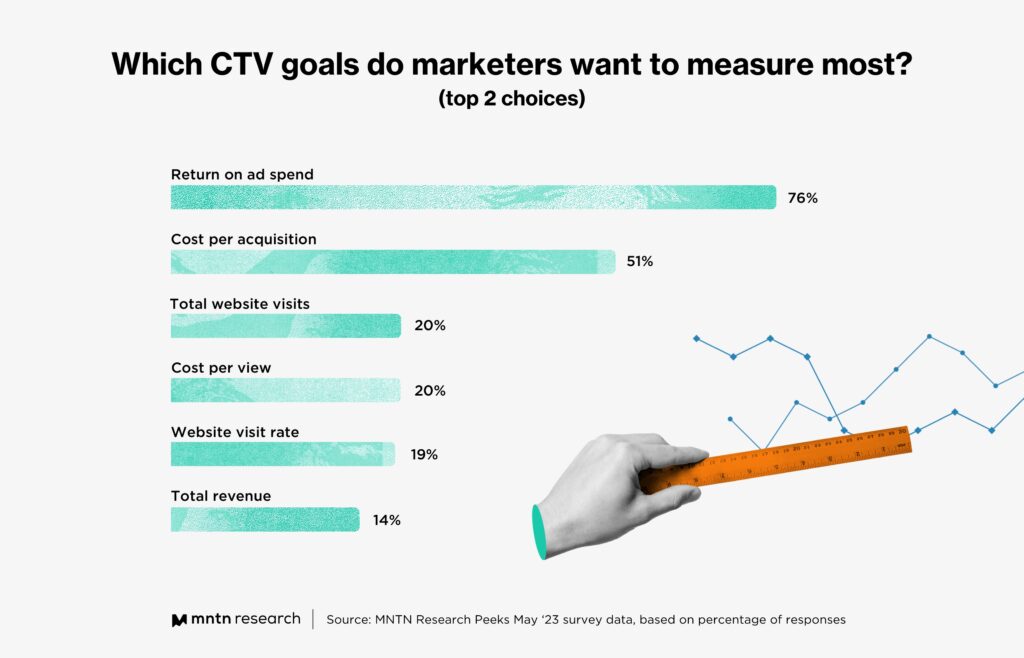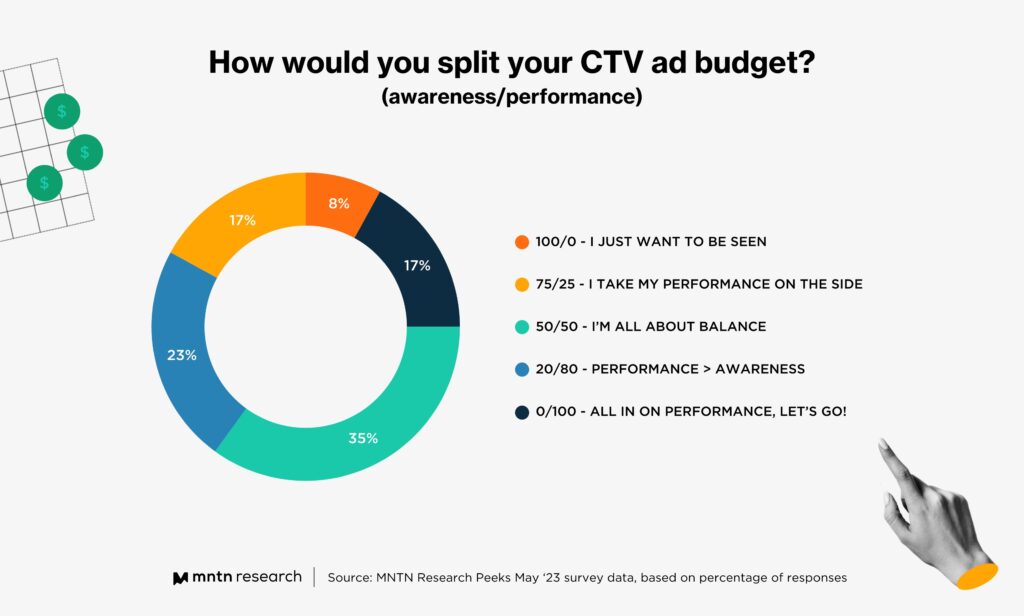Peeks Report
Money In, Money Out: Metrics That Matter to CTV Advertisers
by Tim Edmundson6 min read
Abstract
- Surveyed marketers say they’d most like the ability to measure return on ad spend and cost per acquisition for their CTV campaigns.
- Roughly one in five of those surveyed also said they’d like trackable website visits and visit rate when running CTV.
- When determining the percentage of budget for awareness and performance marketing CTV campaigns, respondents most favored a balanced split.
- Even for more awareness-oriented goals, the ability to track results makes success quantifiable and informs future targeting and creative strategies.
Did you know marketers can measure performance metrics on TV ads now? If you’re already on MNTN Research, there’s a solid chance you already knew. If you didn’t know, then we’re so glad we get to be the ones to tell you.
The rise of Connected TV (CTV) has changed how people watch, how brands advertise, and how marketers treat it as a strategic tool in their kit. TV advertising isn’t just for awareness and branding anymore. There are two main avenues marketers can pursue: awareness and performance.
But what is “performance” on TV? In the grand timeline of advertising, it’s still a very new concept. The word performance can mean different things to different marketers. One way to find out is to identify the results that matter most. Is it ROAS? CPA? Some other marketing jargon combo of all-caps letters?
This new awareness/performance marketing split has budget implications as well. If marketers can use some of their ad spend to drive measurable performance, how will they balance that with the more traditional branding plays?
We wanted to know, so we asked. And you told us (thank you for that, by the way). Let’s dive into how marketers are approaching this new era of TV advertising.
Marketers Love Some Accountability and Efficiency
If you told a group of marketers they could launch a TV ad and then track the return on their ad spend down to the last dollar, we wager three out of four would tell you “that’s amazing, that’s what I want.”
How do we know? Because 76% of respondents told us just that.

We provided a list of common performance metrics and KPIs, and asked marketers to give us their top two. Return on ad spend (ROAS) was the most popular choice, which makes sense. The spirit of performance marketing boils down to knowing you’re bringing more in than putting out. If you can know with certainty that your CTV advertising campaign is delivering a 3x return, then you’re going to run that campaign until it’s no longer profitable.
Knowing that you’re generating a return on ad spend also means you’re doing something right — your message is resonating, your audience targeting is on point — and these are lessons you can take with you to your next campaign.
Coming in at number two was cost per acquisition (CPA), which tells you how much of your budget was used to land a single acquisition on average. This can be anything from a sale, to a signup, to whatever “acquisition” means to you in the context of your campaign.
CPA ranking so high means marketers want to know their budget is spent as efficiently as possible. We’re not in an economic climate where you can go spending ad dollars all willy nilly — marketers need to know they’re getting great bang for their buck. These results show that.
Connected TV Advertising is Still TV Advertising
Website visits, cost per view, and website visit rate all clocked in with roughly one in five respondents picking them as the most desirable metrics. What’s the common denominator among these three? The desire to know ads are generating attention.
That’s because TV is still amazing at doing that, and marketers will still use it for that purpose. If the goal is to drive as much awareness for your brand as possible, the TV screen is top-tier. Be it linear TV or CTV.
Before CTV, television awareness campaigns had to rely on convoluted measurement to gauge success. The fact that you can now see how many viewers visited your website after seeing your ad, and at what rate, is a game changer and carries all the knock-on benefits of knowing that your targeting, creative, message, etc. are all landing with the people you want to reach.
It’s a major advantage knowing your ads are delivering the desired results. To help illustrate this, we’re borrowing a quick case study on the success of a campaign for Steve-O’s (of Jackass fame) hot sauce brand, generated using performance-driven CTV advertising.
Feel free to ignore the “request a demo” CTA at the end, since we’re really not trying to sell to you here. Unless you’re interested in Steve-O’s hot sauce that is, then we are definitely trying to sell to you (it’s pretty good hot sauce)!
Instead, focus on how performance marketing on CTV generates measurable results. Knowing that sales increased and the cost per visit goal performed better than expected gave the marketing team peace of mind that their campaign delivered.
Performance and Awareness, Perfectly Balanced
Hypothetical question. Or maybe not hypothetical if it’s your job to make these kinds of decisions: You’re in charge of the CTV budget, what’s your awareness/performance split?
The most common answer to this question was “give me both.”

While a nice balanced approach was the most popular choice, the answers that leaned toward performance edged out the awareness side (40% to 25% respectively).
Why is this the case? Let’s speculate.
- Accountability is top of mind, and generating measurable return on investment may feel like a better use of funds.
- Performance marketers are keen to tackle a new video ad channel that is outperforming mobile.
- They’re keen to boost other channels like paid search and social, since research shows running performance-optimized CTV ads improve performance on both.
- Or maybe it’s because it’s the new thing in TV advertising, and everyone is at least a little curious.
Whatever the reason may be, it’s clear there’s interest among marketers to tap into CTV’s performance capabilities. Only 8% of respondents rejected the idea completely, saying they’d devote 100% of their CTV budget to awareness.
Performance Marketing Rising on CTV
The general excitement around using CTV as a performance channel lines up with some other research MNTN recently conducted on the topic.
In a survey produced in partnership with Advertising Week, it was found that while 81% of marketers said they use CTV to raise brand awareness, two-thirds also classify it as a performance marketing channel.
When asked “What are you hoping to achieve with your CTV strategy?” the top three answers were as follows.
- 52% – Increase in return on ad spend
- 46% – ID another strong channel in my marketing mix
- 44% – Increase in sales
Interestingly, ROAS topped the list on the survey as well. If there’s any key takeaway from all of this, it’s that marketers really, really, like to know how much of a multiple they’re bringing in. What better way to show your team’s value than that?
Subscribe to the MNTN Research Weekly
Sign up to receive a weekly feed of curated research, sent straight to your inbox.